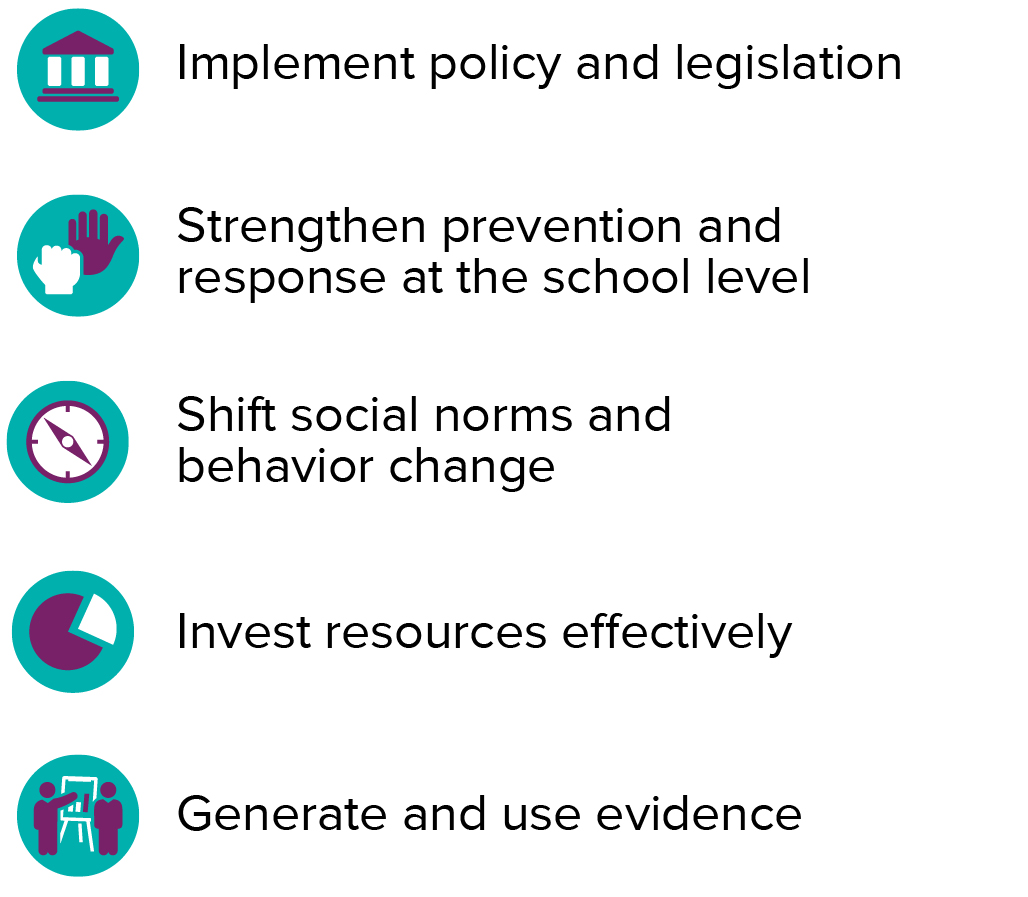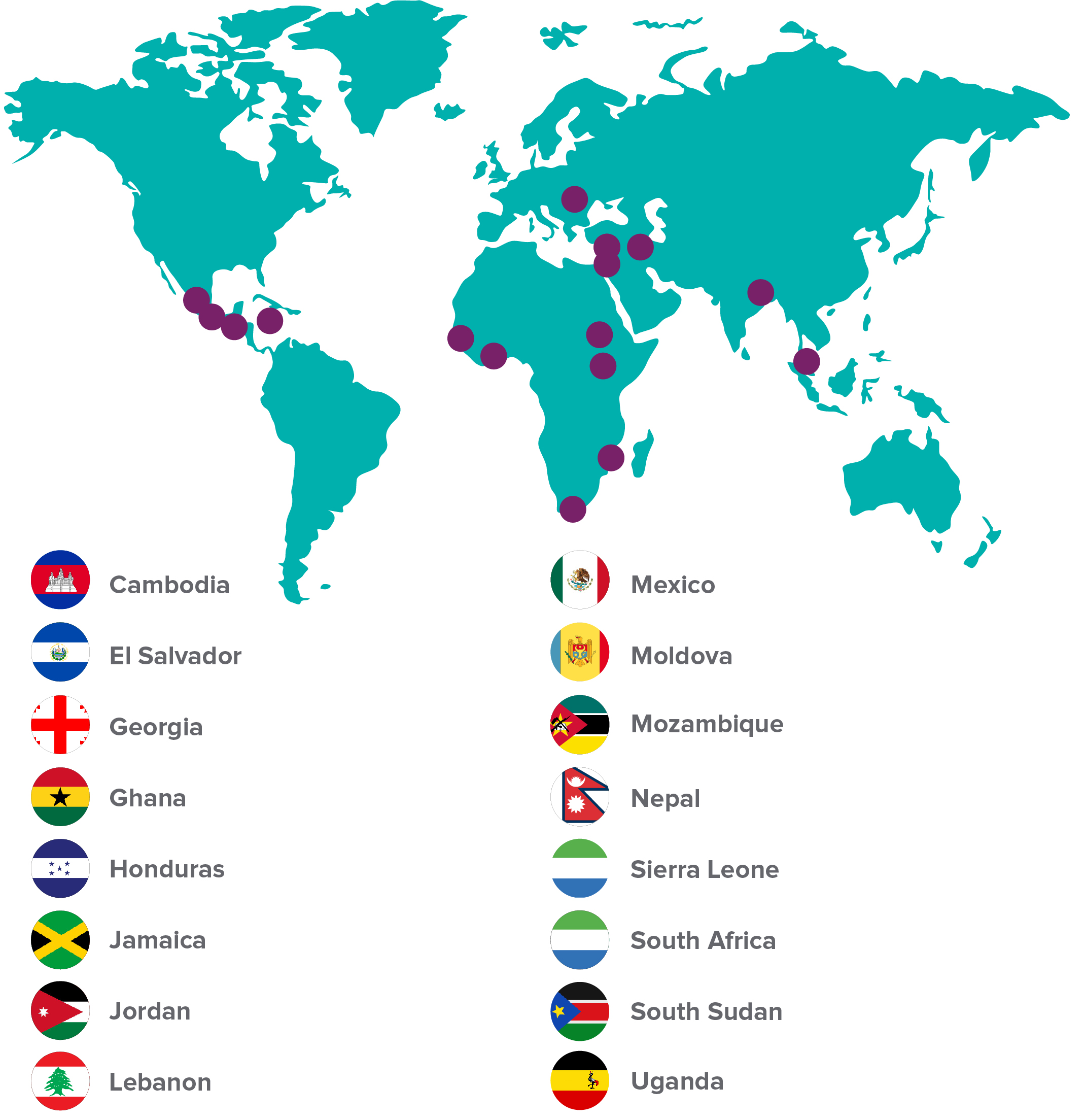Violence can be prevented. Evidence is growing on what needs to be done to do this effectively. Safe to Learn’s work at the country as well as at the global level is rooted in a Call to Action which sets out based on evidence and in high-level terms what needs to be done to end all forms of violence against children and through schools, including:

The Safe to Learn coalition of partners renewed its commitment for collective action to ending violence in and through schools in a new Safe to Learn strategy launched in 2021. The strategy defines country engagement as one of the two intervention pillars of Safe to Learn.
Through Country Engagement, Safe to Learn partners support and collaborate on country and regional-level action to end violence in and through school. The Safe to Learn agenda is universal and applicable to all countries, regardless of income level and wherever they stand on the humanitarian-development continuum. Country engagement at Safe to Learn follows a differentiated, gender transformative and inclusive approach which responds to the unique context and entry points of each country, covering a range of countries and contexts, and testing out different methodologies for working together at country level.
Through its differentiated approach Safe to Learn:

A key aspect of accelerating progress towards ending violence against children is the dissemination of evidence, expertise and tools on what works to end violence in and through schools and ensure every child, in all their diversity, is safe to learn.
Safe to Learn Regional Roundtables provide a platform for sharing knowledge, expertise, and tools and for informed peer to peer dialogue to accelerate progress to ensure all girls and boys have access to safe learning environments where they can learn, thrive and grow. The roundtables offer the opportunity to:
The Safe to Learn roundtables are designed around the Call to Action as the common, clear, and actionable high-level framework, endorsed by STL members and country endorsees. The thematic focus of each roundtable is decided with countries and expert Safe to Learn members that volunteer to be part of the initiative, around the specific priority needs of participating countries. The roundtables format provides participants with the opportunity for active cross-country peer-to-peer dialogue and for sharing knowledge, expertise, tools on what works to prevent violence in and through schools, as well as challenges faced across countries in this field. Roundtables follow rigorous standards of peer-to-peer dialogue and learning processes, to maximize efficiency and effectiveness in bridging policy, practice and learning and best serve countries to make a real difference for children and students around the world.
The roundtables target countries that have endorsed the Call to Action. Additional countries that have expressed leadership and vision in ending violence in and through schools are welcome to join.
The Safe to Learn roundtables cover a wide spectrum of countries in the following regions:
To learn more about the Safe to Learn Regional Roundtables access the Concept Note of the Safe to Learn Regional Roundtables Series (2022-24) here in the Concept Note or click on the correspondent regional tab above.
The Roundtables are designed and coordinated by the Safe to Learn Regional Roundtables Task Force, to which the Safe to Learn global coalition of partners delegated the conceptualization and implementation of this initiative in 2022. Led by the Safe to Learn Secretariat, the Task Force comprises five members of Safe to Learn that expressed interest and volunteered to be part of it and lead this initiative together, including: the CSO Forum to End Violence Against Children (CSO Forum), Global Partnership for Education (GPE), UNESCO Headquarters, UNICEF New York Headquarters, and the Safe to Learn Secretariat/End Violence Partnership. The Task Force collaborates with Safe to Learn partners and organisations. End Violence Lab at the University of Edinburgh, which serves as methodological advisor for the initiative, to ensure that the Safe to Learn roundtables follow rigorous methodological standards of peer-to-peer dialogue and learning processes.
Complementing the Regional Roundtables are Policy Dialogues. Policy Dialogues are carefully constructed meetings where public, private and civic sector leaders come together to exchange information, discuss technical complex issues, and build consensus on recommendations and necessary interventions to tackle violence in and through school within countries.
With children in every country experiencing violence in and around school, governments need informed planning and action at the national and sub-national levels to ensure protection in and through school.
Safe to Learn engages with countries – particularly with the Call to Action endorsees – providing technical and financial support to implement the five pillars of Safe to Learn’s Call to Action. The call to action is a high-level framework for programmatic and policy change to ensure all children are safe to learn. Endorsing the Call to Action demonstrates that a country is, at a senior political level, supporting the end of violence in and through schools, making them safe spaces for children and young people to learn, thrive and grow. It gives Governments a platform to showcase their efforts and share their progress including through events, communications and learnings.
Download the Call to Action (also available in French and Spanish)
To support countries in in their efforts towards ending violence against children in and through schools, by implementing the Call to Action the Safe to Learn initiative has developed a package of technical resources including:
Download the Safe to Learn Programmatic Framework and Benchmarking Tool here.
Also available in French and Spanish.
Download the Safe to Learn Diagnostic Tool here.
Also available in Arabic (version adapted to Jordan context)
Safe to Learn Diagnostic Tool and interview guides adapted to the Jordan context (Arabic)
Between 2019 and 2021, five countries – Jordan, Nepal, Pakistan, South Sudan, and Uganda – have undertaken country diagnostics on their efforts to make schools safer for children using the Safe to Learn diagnostic tool.
Read the country reports of the national diagnostic studies from Jordan, Nepal, South Sudan, and Uganda and the synthesis report summarizing main findings from Nepal, Pakistan, South Sudan, and Uganda or access the two-page summary .
Safe to Learn has also published a report that describes and analyses the diagnostic process in South Sudan and Uganda, and documents lessons learned, challenges and opportunities. You can read it here.
On November 16, 2021, Safe to Learn, together with UNICEF and UNESCO, hosted an event to present the Diagnostic Tool and showcase the experiences of 3 countries: Jordan, South Sudan and Uganda. Watch the event here. Want to help spread the word? Access the Social Media kit.
On 3-4 November 2022, Uganda organised a national symposium to review the progress of the implementation of the Safe to Learn diagnostic study recommendations. Read the Proceedings Report for the Second Safe To Learn National Symposium 2022 in Uganda.
For countries that undergo the diagnostic exercise, Safe to Learn will provide funding through the Safe to Learn Fund to support the implementation of key priorities identified through the diagnostic exercise. The replenished, catalytic, End Violence Fund will work alongside partners to:
To access examples of interview guides that have been used as of now by pioneer countries please navigate the following resources:
Safe to Learn works through partners and donors in education by supporting them to mainstream violence prevention in their investments and projects, including through the Global Partnership for Education and Education Cannot Wait.
Safe to Learn and Education Cannot Wait (ECW)
Education Cannot Wait (ECW) is one of the key actors working within the education space with expertise in delivering education to children affected by crises. In collaboration with ECW, Safe to Learn is working to support responses in Education in Emergencies and Protracted Crises, beginning with the development of operational guidelines to mainstream violence prevention mechanisms in education in emergencies (EiE), with a particular focus on ECW grants. The guidelines are supported by a complimentary Results Framework and a set of indicators to monitor and evaluate progress and will be disseminated at the country level through a series of introductory workshops.
Safe to Learn and Global Partnership for Education
Safe to Learn will also work with and through the Global Partnership for Education (GPE) to mainstream a safe learning lens in GPE grants, National Education Sector Planning processes and Country Compacts. As part of this effort, Safe to Learn will develop gender-responsive guidelines to support GPE staff and country leads in integrating violence prevention and response mechanisms in new GPE grants. A results framework will accompany the operational guidelines providing additional support for countries preparing country compacts as part of the GPE’s Girls’ Education Accelerator.
Safe to Learn works alongside Pathfinding – a priority area of work at the End Violence which aims to raise awareness and support countries to develop national violence prevention strategies.
Safe to Learn, together with Pathfinding, will identify High-Income Countries (HIC’s) that have demonstrated a strong interest in violence prevention and will support them to integrate violence prevention and response mechanisms (including relevant indicators and results frameworks) within their National Action Plans (NAPs) and Education Sector Plans (ESPs).